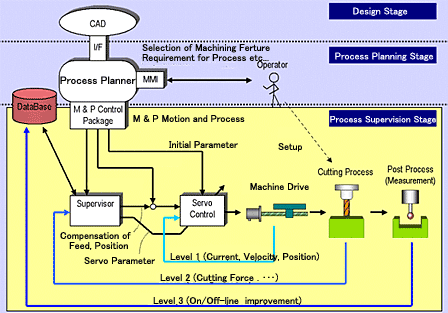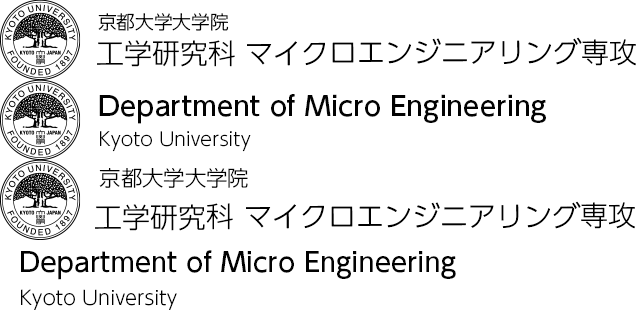Precision Measurement and Machining
Machining and manufacturing technologies are one of the backbone technologies for the today's entire industry. The Machining, Measurement, and Control Laboratory researches various issues to further automate and intelligently control machining and manufacturing processes. NC (numerically controlled) machine tools play a central role in a flexible manufacturing system. Technical innovation on technologies related to an NC machine tool is of critical importance for today's manufacturing industries.
Current research projects include various approaches to high-speed, high-efficiency machining by the intelligent control of NC machine tools. Intelligent technologies to innovate die and mold manufacturing are also our important research topics. Motion control issues on high-accuracy positioning systems from the viewpoint of control, measurement, and design, are also actively researched. Novel machine tool mechanisms, such as a parallel kinematics machine tool or a linear motor driven machine tool, is also one of key technologies to drastically improve the performance of NC machine tools.
Academic Staff
* Add ".kyoto-u.ac.jp" to each E-mail address.
Atsushi MATSUBARA
 Professor (Graduate School of Engineering)
Professor (Graduate School of Engineering)
Research Interests
Professor Matsubara has been working on micro machining, and high precision positioning as a key technology for micro machining. For the implementation of higher accuracy and higher productivity manufacturing technologies, various research topics are actively researched from the viewpoint of mechanics, measurement, design, and control.
Contacts
Room c1S07, Building C3, Katsura Campus
TEL: +81-75-383-3675
E-mail: matsubara@prec
Daisuke KONO
 Associate Professor (Graduate School of Engineering)
Associate Professor (Graduate School of Engineering)
Research Interests
Dr. Kono has been working in a machine tool structure and mechanical elements for high-speed and high precision machine tools. His latest studies focus on the evaluation of static and dynamic properties of machine tools, the optimization of a supporting system for machine installation, the development of a machine using advanced materials, the accuracy improvement of feed drive systems and the contact mechanics.
Contacts
Room c1S08, Building C3, Katsura Campus
TEL: +81-75-383-3676
E-mail: kono@prec
Research Topics
Intelligent NC Machine Tools
In order for higher productivity manufacturing, recent technological development has rapidly commercialized high-speed flexible NC (numerically controlled) machine tools such as a machining center. In today's manufacturing industry, however, such high-speed, high-acceleration machining centers are not widely accepted except for some specialized uses. In order to optimize the productivity while meeting the requirement for machining accuracies, the process planning to fully utilize the potential of high-speed machining centers is quite difficult even for expert machine operators.
As one of major research projects, our laboratory has been working on the development of a manufacturing system that can autonomously perform a high speed machining without requiring knowledge and experiences of an expert operator. We have been actively researching on various issues related to the autonomous high productivity machining by the Intelligent NC (INC) machine tool. Major features of the Intelligent NC machine tool are summarized as follows :
- A database to autonomously determine the optimal machining conditions and control parameters.
- The monitoring and an on-line adaptive control of machining processes.
- The feature-based process planning based on canned cycles.

Figure 1 System Configuration of the Intelligent NC Machine Tool
Servo Control of Feed Drive Systems
In recent years, machine tool manufacturers have been commercialized high speed, high acceleration NC machine tools. Motion control issues in a feed drive system of NC machine tools became of more importance due to such a recent trend of high speed machining.
For example, on high-speed and large-sized NC machine tools, or on linear motor driven feed drives, the structural vibration caused by the driving force is a critical issue for high accuracy positioning. We have been actively researching such an issue related to the motion control of a high accuracy feed drive system from the viewpoint of design, measurement, and control.

Figure 2 A test stand of feed Drive system

Figure 3 A machining center in our laboratory (by Yasuda Kogyo Co., Ltd.)
High Productivity Manufacturing of Dies and Molds
Die and mold manufacturers in Japan are well known all over the world by their high skills. For the machining of dies and molds, the skill of expert operators is still considered crucial. Even in Japan, however, the number of such experts has been decreasing in recent years. Considerable research efforts have been devoted both in the industry and the academia to replace, or preserve, the knowledge and experiences of expert operators by introducing computer-aided technologies.
Our group has been working on the intelligent machining of dies and molds mainly from the viewpoint of CAD/CAM and process planning. Recent research topics include the optimization of machining conditions based on the cutting force control, the tool path planning to avoid an excessive tool load in high speed machining of pre-hardened steel, a process planning based on canned cycles, and the development of practical machining database.

Figure 4 An example of machining of an iron mold by a radius end mill (a screen capture on a CAM software)

Figure 5 A product actually machined
Motion Control of Parallel Kinematics Machine Tools
Since the 90s, several machine tools of a completely different architecture from conventional machines have been proposed. A parallel kinematics machine tool, driven by parallel links and rotary joints, is one of them.
On a parallel kinematics machine tool, a spindle position can be controlled with 6-DOF (degrees of freedom) by independently manipulating six struts. To be widely accepted in the market, it has still many inherent and critical problems to be solved. For example, the deformation due to the gravity is a critical issue to improve the positioning accuracy of parallel kinematics machines. Furthermore, since a spindle unit is supported only by struts, the stiffness against the disturbance, such as a cutting force, is often not as high as that of typical serial-mechanism machines.
To address such an issue, our group has been working on various issues for higher accuracy motion control of parallel kinematics machine tools.

Figure 6 A parallel kinematics machine tool (by Okuma Corp.), performing a DBB test for the calibration of kinematic parameters.

Figure 7 Motion accuracy analysis of a parallel kinematics machine tool on a 3D CAD
